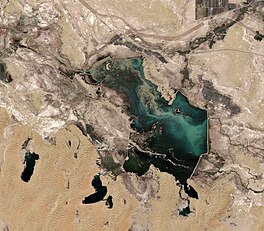| This article is an orphan, as no other articles link to it. Please introduce links to this page from related articles; try the Find link tool for suggestions. (April 2022) |
| Daxihaizi Reservoir | |
|---|---|
| Da Xihaizi Reservoir | |
| 大西海子水库 | |
 Sentinel-2 image (2022) Sentinel-2 image (2022) | |
 | |
| Location | at the end of the Tarim River |
| Coordinates | 40°34′18″N 87°31′13″E / 40.57167°N 87.52028°E / 40.57167; 87.52028 |
| Type | reservoir |
| Basin countries | China |
| Built | 1972 |
Daxihaizi Reservoir (Chinese: 大西海子水库), also spelled Daxi Haizi Reservoir or Great West Sea Reservoir, is a reservoir at the very end of the Tarim River, 720 km from Urumqi. To the west of the reservoir is the Taklamakan Desert. The reservoir has a storage area of 68 square kilometers, a depth of 2-3 meters, and a total storage capacity of 168 million cubic meters.
History
In 1958, the soldiers of the Second Division of the Xinjiang Production and Construction Corps began to build the Daxihaizi Reservoir. In 1972, after the completion of the reservoir in the middle reaches of the Tarim River, the 320-kilometer section of the lower Tarim River dried up. In 1974, Taitema Lake completely dried up.
In 1993, the Daxihaizi Reservoir dried up completely for the first time in its history.
In 2012, the reservoir was withdrawn from the agricultural irrigation system, and became a purely ecological reservoir. In May 2014, the Daxihaizi Reservoir was officially transferred from the XPCC to the Tarim River Basin Bureau (塔里木河流域管理局).
References
- "A lonely and persistent river flows between two deserts". Xinhuanet.com. 2019-09-10.
- "Tarim River receives third water replenishment". Radio Free Asia. 2001-04-27.
- "Research on the Early Warning Model of Environmental Desertification Based on Grid Scale" (PDF). Nature Environment and Pollution Technology. Jul 28, 2019.
- Ståhlberg, Sabira; Svanberg, Ingvar (November 15, 2010). "Loplyk Fishermen: Ecological Adaptation in the Taklamakan Desert". Anthropos. 105 (2): 423–439. doi:10.5771/0257-9774-2010-2-423. JSTOR 25734813.
- Č Maksimović; David Butler; Fayyaz Ali Memon (2003). Advances in Water Supply Management: Proceedings of the International Conference on Computing and Control for the Water Industry, 15-17 September 2003, London, UK. Taylor & Francis. pp. 707–. ISBN 978-90-5809-609-8.
- Journal of Geography. Chinese Geographical Society. 2007.
- "Witness the green changes of today and tomorrow". Sina. Aug 11, 2017.
- "Daxihaizi Reservoir was officially transferred to Tarim River Basin Bureau". Xinhua News Agency. 2014-05-29.
- "Water to Flow Again in Dry Section of China's Longest Inland River". People's Daily. April 27, 2001.
- Liu Chan (2018). A Study on the Construction of a Natural Resource Property Rights System in China. Sonbook Publishing Co., Ltd. pp. 296–. GGKEY:LBUETBXRD3Q.
- "7 billion cubic meters of ecological water transported to revitalize the Tar River basin". Sina. 2018-08-10.
- "Largest lake in history formed downstream of Tarim River". Wenhui Bao. Nov 12, 2017.
- "The Second Division of the Corps and the local hand in hand to build the Tower River green ecological home". Sina. Jun 19, 2014.
This article related to a lake in China is a stub. You can help Misplaced Pages by expanding it. |